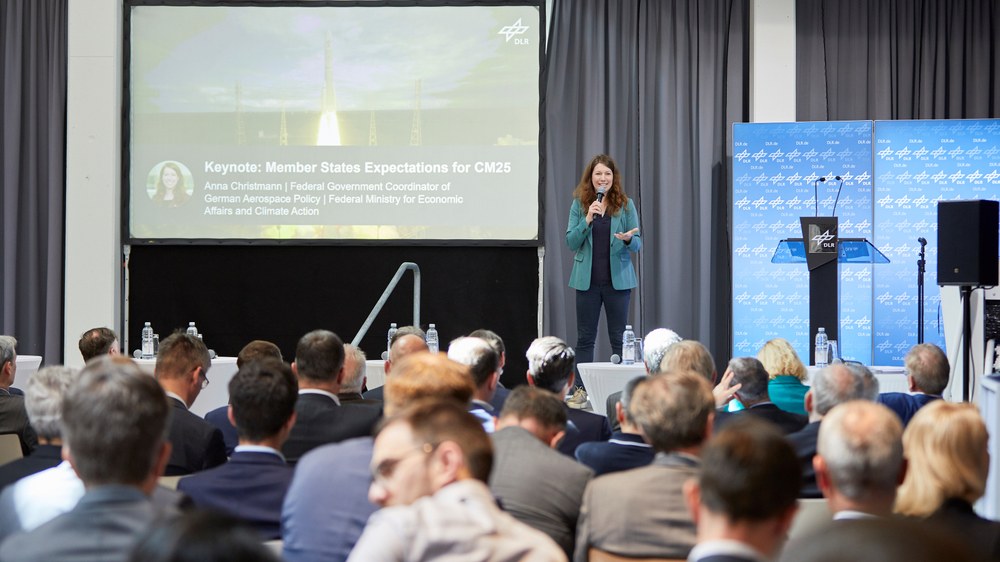12th DLR Industrial Days spark momentum for Europe's evolving space transport sector



- From 15 to 16 April 2025, leading representatives from the space industry, space agencies and research institutions gathered for the 12th Industrial Days at DLR's Lampoldshausen site.
- Amid geopolitical shifts and technological progress, competition and market potential in the launcher sector have evolved rapidly. The associated challenges were at the heart of discussions.
- Focus: Space, space transport, launcher systems, New Space
Independent access to space is more important than ever – a strategic imperative, making it all the more important for Europe to achieve autonomy in the launcher sector. Yet today's challenges are multifaceted, with the launcher market more fragmented, more international and less standardised than in the past. On 15 and 16 April 2025, around 100 experts from space agencies, politics, industry and research met at the 12th Industrial Days in Lampoldshausen, hosted by the German Aerospace Center (Deutsches Zentrum für Luft- und Raumfahrt; DLR) and the German Space Agency at DLR, to discuss how Europe’s space transport sector can reorganise and adapt in the face of mounting demands.
"For over 60 years, DLR has focused its research and testing activities in Lampoldshausen on the needs of the European launcher market," says Chair of the DLR Executive Board Anke Kaysser-Pyzalla. "The success of European launch vehicles is the result of close cooperation between research and development and the European space industry. This collaboration is essential to Europe's autonomous access to space."
Turning challenges into opportunities – Europe's launch market in transition
Under the theme 'Access to space at crossroads?', the event explored current developments, strategic decisions and emerging technologies. The demands placed on Europe's space transportation sector are growing rapidly – from technological progress and an increasingly dynamic market environment to increasing global competition. "European space transport must now actively change shape in order to keep pace internationally," emphasised Walther Pelzer, DLR Executive Board member and director general of the German Space Agency at DLR. "This will only succeed with a spirit of innovation, determination and clear political will, as governments are increasingly acting as anchor customers and procuring launch services."
Reliability and high payload capacities characterised the large launch vehicles of past decades, but success in today's highly competitive market requires excellence in other areas, as Pelzer explains: "Cost effectiveness, flexibility and rapid deployment will determine whether a launcher will prevail. The future of European space flight is just beginning."
Market-oriented and open to technology – approaches for sustainable access to space
Despite complex challenges, significant successes have recently been achieved in European space transport. Since the last Industrial Days in 2024, Ariane 6 has successfully completed not only its inaugural flight, but also its first institutional-commercial mission launch – a decisive step forward for Europe's heavy-lift capabilities. Key components such as the Vulcain 2.1 main stage engine, the Vinci upper stage engine and the Auxiliary Propulsion Unit (APU) were tested under real flight conditions. In December 2024, the upgraded Vega-C rocket also lifted off from Europe's Spaceport in Kourou, French Guiana, carrying the Sentinel-1C satellite from the European Copernicus Earth observation programme. These missions marked significant progress towards operational readiness and securing Europe's autonomous access to space.
New German players from the private sector have also reached important milestones. In May 2024, HyImpulse successfully trialled its SR75 suborbital rocket, powered by a paraffin-based hybrid propulsion system in Australia and reaching an altitude of approximately 50 kilometres – the company's first demonstration of the technical viability of its concept. More recently, at the end of March this year, Isar Aerospace carried out a test flight of its Spectrum orbital rocket, demonstrating the potential of private-sector spaceflight solutions in an increasingly diversified launch market. A third German start-up, Rocket Factory Augsburg (RFA), is planning the first test flight of its RFA ONE orbital rocket later this year. "These developments show that Europe's space transport can rely on both proven systems and innovative ideas – a combination that will be a decisive success factor in global competition of the future," says Stefan Schlechtriem, Head of the DLR Institute of Space Propulsion.
DLR Lampoldshausen – flexible in the face of change
DLR Lampoldshausen's test rig capabilities reflect the evolving needs of the market. Thanks to its flexible, efficient and scalable test infrastructure, the facility is paving the way for a smooth transition to future propulsion systems, while making the best possible use of existing resources in terms of infrastructure and expertise. "The tecent investments we have made in modern test infrastructure allow us to effectively adapt to dynamic changes in the European launcher landscape," Schlechtriem explains. "For DLR in Lampoldshausen, being ready for the future doesn't mean choosing between old and new, but enabling established and emerging space players to work side by side. This flexibility forms the foundation to remain Europe’s most capable and efficient test and research centre for liquid propulsion systems of all sizes and specifications."
